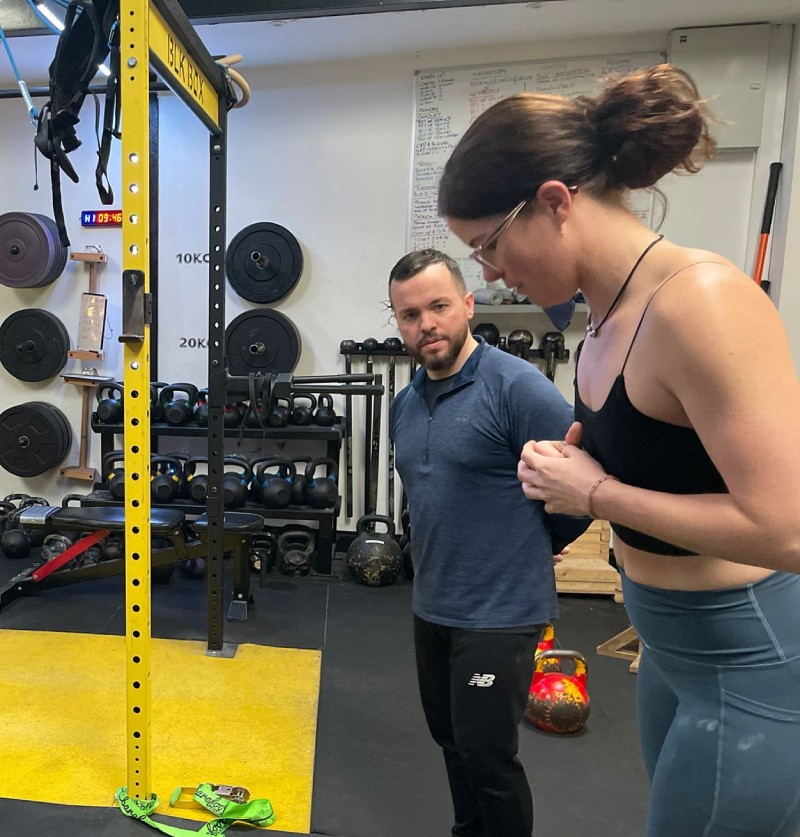Having a good pre-workout routine is super important, especially for women looking to make the most of their workouts. Whether […]
Coaching Sessions: Mon-Fri, 6/7/9am & 5/6/7pm
close


In part one of this blog (read it here) I discussed how strength & conditioning for fighters has evolved from the days when boxing ruled, to the birth of MMA and its new, more scientific methods. Strength coaches are part of the background in an MMA team, we are like the mechanics in an F1 team. Our work isn’t glamorous but without it, the driver (fighter) doesn’t have as good a chance of winning. When our methods are effective we won’t get much of the attention but if it fails, we will, for all the wrong reasons. It can be extremely gratifying to watch a fighter you have worked with improving fight by fight, knowing that you are a link in the chain to this improvement. That said, it is easy to overthink S&C and end up doing more damage than good.
In part two I want to share some simple rules that in my opinion, anyone coaching any type of fighter must keep in mind.
RULE #1: The main focus of strength training should be injury prevention.
This is the real purpose of S&C. As a coach your #1 goal is to make the body as bulletproof as possible. In a twelve-week fight camp the fighter is going to pick up injuries, its inevitable, so aim to build their bodies so as they are strong enough to deal with the knocks and bumps. I have yet to experienced a camp that has run smoothly so the less damage these knocks do, the better chance your fighter will have of training at their optimal level.
RULE #2: Strength training should not interfere with the athletes sport.
This is crucial when training someone such as an athlete. What you do should enhance the fighters performance. If they are arriving for their skills or sparring sessions feeling sore and beat up then they won’t be training at their optimal level. Some coaches get pleasure in pushing their fighters to a point of near collapse (in the beginning I was one of these types) but screaming at your fighter for one more rep or to give you another 20 seconds, when they are already at the edge of their limit is just plain stupid. Why risk injury just to prove they can push out one more ugly rep that risks them injuring themselves? Some people will justify it by saying it builds character and heart but in my opinion, that’s what sparring sessions like the shark tank or gauntlet (if you are a fighter you will know what that is, if you aren’t, count yourself blessed) is for and even that should be used sparingly. Save the dig down to the bottom of your soul efforts for those times in the cage/ring.
RULE #3: Mobility and movement.
I see so many fighters who look in great shape but can’t touch their toes. The saying “you are only as strong as your weakest link” is true. What is the point in coaching a fighter to deadlift 250kg for fun if they struggle to lift their hands above their heads? Increasing their mobility will increase their range of motion. This opens up sweeps, submissions and the ability to strike from different angles. Fighting is basically a dance and dance is movement.
In my gym I have witnessed fighters who are beasts in the weight room, get destroyed by guys over 20kg lighter, simply because their opponent had great mobility and beautiful movement. The ability to control your body in every plane requires great strength. The more I study movement the more I realise how strong its crossover to fighting is.
RULE #4: Focus on full body movements.
They are fighters, not body builders. You aren’t going to win because your six pack is better. Look for the movements that give you the most bang for your buck and try and replicate movements that take place in a fight. Deadlifts, Bulgarian split squats, Turkish get-ups, power cleans, gymnastic ring work and balance drills. I always focus on building a strong posterior chain with my fighters, the back, the glutes and the hamstrings. This is where the power is found. The fighters with the biggest posterior chain are alway the most explosive.
RULE #5: Build power
You are trying to build strength and explosive power not size. Remember speed kills. The faster and more explosive they are the harder they can hit. The last thing you want happening is your fighter to become muscle bound. Stick with me while I get a bit technical for a few lines, I apologise and will keep it as simple as possible.
Muscle growth is referred to as hypertrophy. There are two types. The first one is what bodybuilders aim for and is known as sarcoplasmic hypertrophy. This is where sarcoplasm (fluid) is pushed into the muscles cells causing them to swell and grow, exactly what a fighter wants to avoid.
The second type is known as myofibril hypertrophy. With this style of training you’re enhancing the actual size of the muscle fibres. Myofibrils are able to contract during exertion and the more you have of them, the more power your muscles can summon when they need to actually perform work. Adding more fibres makes your muscles denser but not noticeably bigger. How do we do this? by following rule #6.
RULE #6: Keep the reps low, the rests long and the weight relatively heavy.
In my opinion, reps should total no more than 10 for lower body and up to 25 in total for upper. There are numerous ways to achieve this and they all work, 3×3, 5×5, 2×5 5×1 but I personally like to stay away from singles and doubles and work with in the 3-5 range thus staying away from going close to their 1rep max. Just like they aren’t bodybuilders, fighters are also not power lifters. The closer you go to their 1RM, the more risk their is of injury. Strong enough is good enough for me. I like to pick a weight that’s comfortable and work with it until it becomes easy, then increase and repeat. This way I avoid burn out and they remain fresh for their sparring.
Rest times between sets, as far as I’m concerned, should be as long as possible. WARNING (another slightly scientific bit coming up). A muscle contraction is like a light switch, it is either on or off, there can’t be a half contraction. The strength of the contraction is dictated by the nervous system. When you lift a weight that the nervous system deems heavy i.e. 85-100% of your 1RM, it will have used up a lot of energy and become fatigued. It takes around 5 minutes for it to recover (this is why the likes of powerlifters and Olympic lifters take so long between sets) The more rest you can take between sets will mean the CNS (central nervous system) will have had longer to recover, meaning you will have more strength to call on.
RULE #7: Focus on weaknesses.
A coach is different from PT. Our job isn’t to provide a service to get them fit. It is to find where they are weak and fix that. I said it earlier but it is worth repeating “you are only as strong as your weakest link”. Every fighter is different and will require individual attention. For some it will be strength, some will have movement and mobility issues, for others it will be both. Your job is to work out what that is and then find the simplest way of addressing it. Trying to run a class style session does not work, they need 1:1 attention with a structured program that they can follow themselves.
RULE #8. Start with cardio
This is something I have struggled to accept. For years I have believed that cardio was the evil of the S&C world but recently I attended the Strength Matters Summit and listened to a very well respected coach called Andrew Read (check him out here http://www.readpt.com) and now, I realise its a necessity. The key is to doing it right. Fighting, like most things we do in life, is a cardio based sport. The higher I can increase my aerobic zone, the longer I can maintain a faster pace, without entering the aerobic zone. If I can get my fighters aerobic threshold to a level higher than their opponents, then it will enable him to push the pace and sustain it for longer, pushing his opponent into an anaerobic state. From this point, it is simply a matter of time. In order to do this correctly, you need a plan and some time!
A fight camp is usually around 12 weeks and if your fighter is anyway the professional he should be keeping a certain level of year round fitness. The fitter he or she is at the start of this, the better they will be come the end. At the beginning of the camp, long steady runs is whats called for, making sure the heart rate is kept at a level that keeps him in his aerobic comfort zone, a heart monitor is advised for this. Over the weeks the plan is to expand this zone so that come 4-5 weeks out from the fight, they are at a level where they can run at a pace that in the beginning, would have seen them enter an anaerobic state. When they are at this point the higher intensity work should start. This is what I like to call RR (round replication), a well know example would be “The Shark Tank”, a fresh fighter, every minute on the minute, for 6 minutes, the pace is always high, the opponents are always fresh and strong. Your fighter will be working in their anaerobic zone for these rounds but will find time to rest and recover. The aerobic foundation they have laid leading up to this will come into effect in these recovery moments, delaying the time it takes to once again enter into the anaerobic zone.
There you have it, a very simplified guide to strength training, Focusing on keeping everything as simple as possible and remembering your main goal is to keep the fighter injury free should help your team improve and hopefully produce champions.
Having a good pre-workout routine is super important, especially for women looking to make the most of their workouts. Whether […]
Do you ever find it hard to squeeze in exercise with all the other stuff going on in your life? […]
Did you know that adding a strength training plan for runners to your routine can make you even better at […]
